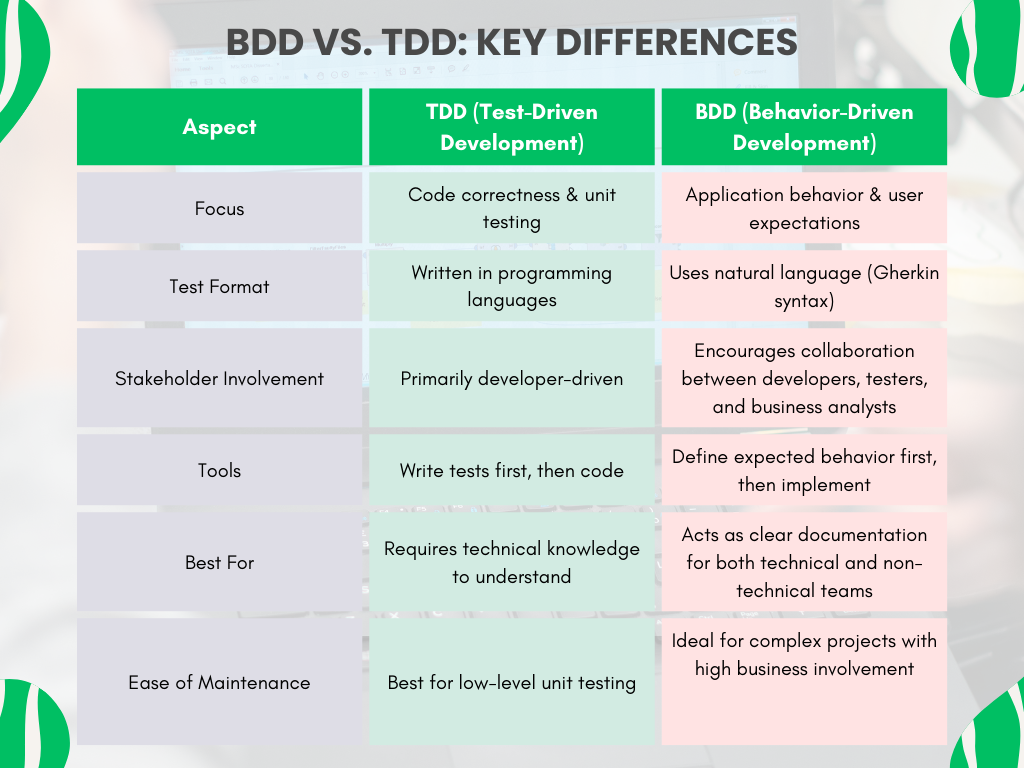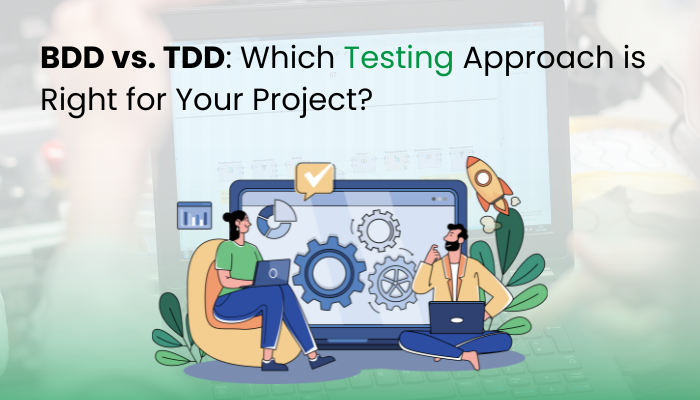Software testing plays a crucial role in delivering high-quality, bug-free applications. Among the many testing methodologies, Behavior-Driven Development (BDD) and Test-Driven Development (TDD) stand out as two of the most popular approaches. Both emphasize early testing and collaboration, yet they differ in focus, execution, and outcomes.
If you’re wondering which approach- BDD vs. TDD- is best for your project, this article will provide a detailed comparison to help you make an informed decision.
What is TDD (Test-Driven Development)?
Test-Driven Development (TDD) is a software development approach where tests are written before the actual code. It follows a “Red-Green-Refactor” cycle:
- Red – Write a failing test based on the requirement.
- Green – Write just enough code to pass the test.
- Refactor – Improve the code while ensuring tests still pass.
Benefits of TDD
- Faster Bug Detection- Writing tests first ensures that issues are caught early.
- Improved Code Quality- TDD enforces writing modular, testable, and maintainable code.
- Better Design- Developers think through implementation details before coding.
- Lower Debugging Time- Since tests are already in place, debugging becomes easier.
Limitations of TDD
- Time-Consuming- Writing tests before coding can slow down initial development.
- Not Ideal for UI Testing- TDD works well for backend logic but struggles with UI-heavy applications.
- Requires Skilled Developers- Developers must have a strong understanding of test writing.
What is BDD (Behavior-Driven Development)?
Behavior-Driven Development (BDD) extends TDD by focusing on behavior rather than implementation. BDD uses a common language that is understandable by developers, testers, and business stakeholders.
BDD tests are often written in Gherkin syntax, which follows a Given-When-Then format:
- Given- The initial context or setup.
- When- An action is performed.
- Then- The expected outcome or result.
For example, a BDD test for a login feature might look like this.
Feature: User Login
Scenario: Successful Login
Given a registered user
When they enter valid credentials
Then they should be redirected to the dashboard
Benefits of BDD
- Improves Collaboration- Since BDD uses natural language, non-technical stakeholders can participate.
- Better Requirement Understanding- Encourages clear communication of business needs.
- Comprehensive Test Coverage- Focuses on user behavior, ensuring important functionalities are tested.
Limitations of BDD
- Overhead in Writing Scenarios- Writing detailed test scenarios can be time-consuming.
- Learning Curve- Teams must familiarize themselves with BDD tools like Cucumber or SpecFlow.
- Might Not Fit Small Projects- BDD is more beneficial for large, collaborative teams than for solo developers.
BDD vs. TDD: Key Differences

When to Choose TDD
TDD is ideal when
- You are working on complex backend logic where test-driven development ensures correctness.
- You need quick feedback and want to prevent regressions.
- Your team consists mostly of developers who are comfortable writing unit tests.
- The project requires a high level of code coverage and refactoring over time.
When to Choose BDD
BDD is a better choice when
- Your project involves multiple stakeholders, including product managers and testers.
- You need to improve collaboration between technical and non-technical team members
- The application is user-focused, such as e-commerce platforms or customer-facing applications.
- You aim for high test coverage with a focus on real-world scenarios rather than low-level implementation.
Can You Combine BDD and TDD?
Yes! Many teams use BDD and TDD together to leverage the strengths of both approaches.
- Start with BDD: Define the behavior and expected outcomes using Gherkin.
- Implement TDD: Write unit tests to validate each behavior at the code level.
- Execute Tests: Run both BDD and TDD tests to ensure functional and technical correctness.
By integrating both methodologies, you get the collaborative benefits of BDD while maintaining the code-level discipline of TDD.
To Wrap Up
Choosing between BDD vs. TDD depends on your project’s needs, team structure, and objectives.
- If your focus is on code correctness and maintainability, TDD is the way to go.
- If you want to bridge the gap between business and development, BDD is the better approach.
- For maximum effectiveness, a combination of both can provide the best of both worlds.
Understanding the differences between BDD vs. TDD will help you pick the right approach and improve the quality of your software development process. Regardless of your choice, implementing a test-driven mindset will lead to better, more reliable applications in the long run.
Reffrence Blog You Can Also Read this Blog : How BDD and TDD Impact Software Development: A Comparative Analysis
Read Also : Top 10 Visual Regression Testing Tools for Software Testing
 :
https://uk.pinterest.com/testevolve/
:
https://uk.pinterest.com/testevolve/












